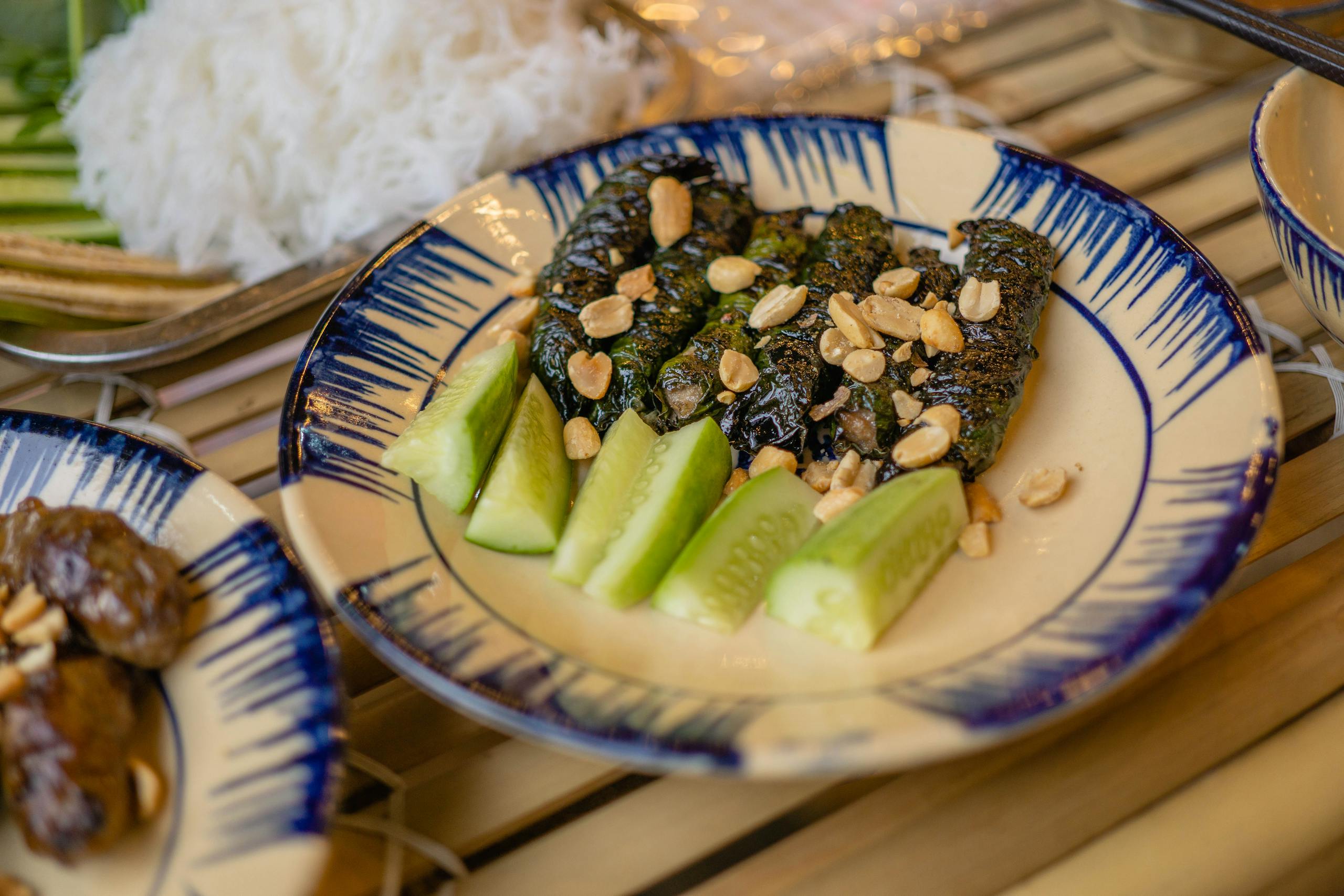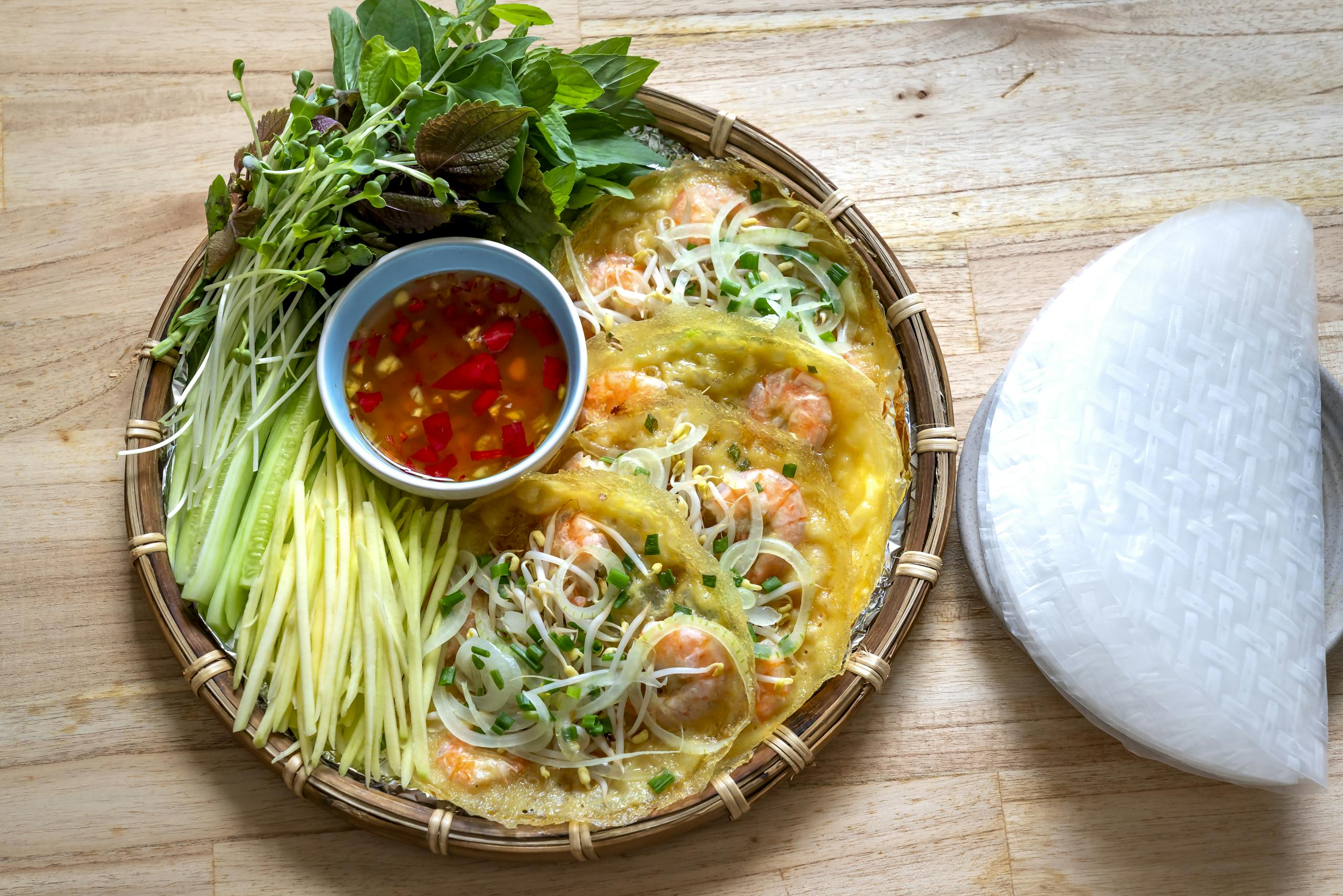Blog » Travel Guides » A Culinary Journey ...
A Culinary Journey Through Vietnam: Discover Authentic Flavors, Street Food, and Dining Culture
Discover the rich and diverse flavors of Vietnamese cuisine as we explore traditional dishes, regional specialties, street food gems, and the unique dining culture. This guide also provides essential food safety tips and etiquette to enhance your authentic culinary adventure in Vietnam.
Key Takeaways
- Vietnamese cuisine uniquely balances five fundamental tastes—sweet, salty, sour, bitter, and umami—using fresh herbs, minimal oil, and diverse cooking methods.
- Distinct regional flavors reflect Vietnam’s geography and history, with the North favoring mild seasons, the Central region offering bold and spicy dishes, and the South showcasing sweeter, herb-rich meals.
- Fish sauce (nước mắm) is an essential condiment that delivers salty umami flavor central to broths, sauces, and marinades across Vietnamese dishes.
- Authentic Vietnamese street food is best experienced by choosing busy vendors cooking fresh food on-site with clean preparation areas.
- Respectful communal dining customs include sharing dishes family-style, serving elders first, and proper chopstick etiquette to honor Vietnamese culture during meals.
- Participating in food tours, market visits, and cooking classes enhances appreciation for Vietnamese culinary heritage and ensures a safe and immersive food experience.
Vietnamese cuisine and food culture bring together fresh ingredients, bold flavors, and unique dining traditions that thrill food lovers everywhere. From savory bowls of Phở to crunchy Bánh Mì sandwiches, Vietnamese food is a tasty journey you won’t forget. Each dish telling a story of heritage, climate, and creativity.
In this article, you’ll get to know the basics of Vietnamese cooking, check out iconic dishes and regional specialties, and explore the bustling street food scene.
Plus, we’ll share handy tips on food safety and local dining customs to help you enjoy an authentic, comfortable culinary experience in Vietnam, whether you’re grabbing a quick bite at a market stall or dining with a family.
Whether you’re planning a trip or just curious about new tastes, come along as we explore the heart and soul of Vietnam’s amazing food culture—one bite at a time.
Introduction to Vietnamese Cuisine and Food Culture

Vietnamese cuisine and food culture revolve around balancing fresh ingredients, vibrant flavors, and colorful presentation.
At many meals’ core is rice – a staple grain that forms the base of countless dishes nationwide – paired with fish sauce, which adds a salty-sweet depth.
Thanks to Vietnam’s tropical climate, there’s a bounty of fresh herbs and vegetables, making dishes light, healthy, and bursting with natural flavors that locals and travelers both love.
What Makes Vietnamese Cuisine Unique?
What really makes Vietnamese food stand out is the masterful way it balances : sweet, salty, sour, bitter, and umami in every dish.
Freshness is king here: unlike many cuisines, Vietnamese dishes use very little oil and skip heavy dairy, relying instead on fresh herbs like mint, coriander, and basil to brighten flavors.
Typical cooking methods – steaming, simmering, stir-frying – keep ingredients natural and fresh.
Another hallmark is communal eating – where varied dishes are shared around the table, strengthening social bonds and showing respect, especially to elders, as seen in the careful dining etiquette.
Cultural Meaning and Worldwide Fame
Vietnamese food is more than just fuel; it’s a reflection of culture and regional variety.
The North, Central, and South each boast unique dishes shaped by their local ingredients, climates, and histories.
Family meals offer meaningful moments of connection and respect, carried out through specific dining customs. Classic dishes like Phở and spring rolls often appear at celebrations and holidays, symbolizing heritage and unity.
On the world stage, Vietnamese cuisine keeps growing in popularity thanks to its iconic dishes that travel well and its reputation for fresh, healthy fare. From lively street stalls in Asia to chic restaurants in Europe, Phở and Bánh Mì have won over foodies looking for a meal that’s both tasty and nourishing.
This global spread proves Vietnamese cuisine is a go-to for those wanting comforting yet exciting flavors.
Core Principles and Key Flavors in Vietnamese Food

Vietnamese food is famous worldwide for its perfect balance of flavors, dedication to fresh ingredients, and use of unique condiments that give each dish its special touch.
Understanding these basics helps travelers, chefs, and food fans appreciate the simple yet deep qualities that define Vietnamese cuisine and culture.
The Five Fundamental Tastes (Ngũ Vị)
At the heart of Vietnamese cooking is Ngũ Vị, the idea of five basic tastes: spicy, sour, bitter, salty, and sweet. Every dish aims to feature or balance these, reflecting a harmony like yin and yang.
These flavors aren’t just about taste – they’re connected to natural elements and believed to support overall health, a key part of Vietnamese food tradition.
| Taste | Common Ingredients | Typical Use |
|---|---|---|
| Spicy | Chili, pepper, ginger | Dipping sauces, broths, marinades |
| Sour | Lime, tamarind, vinegar | Soups (like canh chua), salads |
| Bitter | Bitter melon, local greens | Stews, herbal broths |
| Salty | Fish sauce, soy sauce, sea salt | Broths, marinades, sauces |
| Sweet | Cane sugar, palm sugar, root veggies | Pho broth, desserts, snacks |
Take a classic bowl of Phở, for example—it’s a great example of these five tastes at play: sweetness and umami from slow-cooked beef and caramelized onions; saltiness from fish sauce; spice from fresh chili; sourness from a lime squeeze; and a bit of bitterness from herbs like Thai basil and saw-tooth coriander.
Why Fresh Ingredients and Herbs Matter
Freshness is everything in Vietnamese cooking. Meals lean on heaps of fresh herbs and crunchy veggies, bringing vibrant flavor, great textures, and health benefits.
Common herbs like coriander (cilantro), Thai basil, mint, and culantro often come alongside dishes to lift and balance flavors.
- Coriander (cilantro)
- Thai basil
- Perilla leaves
- Mint
- Culantro (saw-tooth coriander)
- Lemongrass
- Bean sprouts
Vegetables are usually served raw or just lightly cooked, so they keep their crunch and bright colors. This prep method peppers natural flavors and adds a fresh touch to heartier broths and grilled meats. Having these fresh herbs and greens on your plate is a key part of savoring true Vietnamese flavors.
The Role of Fish Sauce and Key Condiments
Fish sauce, or Nước Mắm, is often called the soul of Vietnamese cooking. Made by fermenting anchovies with salt, it gives dishes that essential salty and umami punch felt in broths, marinades, and dipping sauces. It’s hard to imagine authentic Vietnamese food without this strong, flavorful ingredient.
- Featured in broths like those in Phở and Bún Bò Huế
- The base for bright dipping sauces like Nước Chấm, which blends fish sauce with lime, sugar, garlic, and chili
- Key to marinades for grilled meats and seafood
- Other must-have condiments include fermented shrimp paste (Mắm Tôm), fermented soybean paste (Tương), and hoisin sauce
For example, spring rolls (Gỏi Cuốn) are traditionally dipped in Nước Chấm, which perfectly balances sweet, sour, salty, and spicy—kind of like a mini flavor symphony of Vietnamese tastes.
How Geography and Culture Shape Vietnamese Food

Vietnamese cuisine and food traditions are deeply shaped by the country’s unique geography and rich history. These elements create distinct cooking styles across the North, Central, and South regions, each offering travelers a true taste experience tied closely to local climate, ingredients, and culture.
How Climate and Location Influence Regional Foods
Vietnam’s long, narrow shape stretches across many climates and landscapes that shape what’s cooked and eaten in each region.
In the North, cooler temps and fertile river valleys favor dishes with mild, subtle flavors, fresh herbs, and simple seasoning. Up here, you’ll find classics like Phở and Bún Chả, where balanced broths and gentle flavors take center stage.
Central Vietnam, with its mountains and historic imperial cities like Huế, offers spicier, more complex food. This area uses local chilies and shrimp paste to create fiery, aromatic dishes often served in smaller, elegant portions. The food here blends royal influences with coastal abundance.
Down South, the warm tropical climate and fertile Mekong Delta bring vibrant, naturally sweet dishes packed with fresh fruits, herbs, and seafood. Favorites like bánh xèo (crispy savory pancakes) and bún mắm (fermented fish noodle soup) highlight the rich variety of ingredients from local waterways and farms.
Travel tip: The best way to taste authentic Vietnamese flavors affected by climate and place is to try dishes where they originate. For instance, enjoy spicy Central Vietnamese fare in Huế or delicate northern noodle soups in Hanoi for a full sensory culinary trip.
Historical and Cross-Cultural Flavors
Vietnamese food culture beautifully mixes native traditions with influences gathered from trade, migration, and colonization over centuries.
The long Chinese rule left a big mark – techniques like stir-frying, use of soy sauce, and noodle and dumpling dishes showcase this, but always balanced with fresh herbs and lighter seasoning to keep Vietnamese identity clear. Spices like five-spice and fresh garnishes help set Vietnamese dishes apart.
French colonial times also played a big role. The beloved Bánh Mì sandwich arose from French baguettes paired with local meats, pickles, and herbs. French baking, coffee culture, pâté, and slow – cooked stews like Bò Kho remain popular in cafés and street stalls, showing a tasty cultural blend.
The Mekong Delta and southern areas pick up flavors from Cambodia, Thailand, and Malaysia too. Things like coconut milk, curries, and peanut sauces add new textures and tastes, enriching Southern Vietnamese cooking.
Indigenous ethnic groups in the mountains bring old cooking methods like bamboo steaming, fermentation, and wild herb foraging. These traditional styles offer authentic, less-commercial flavors often enjoyed by adventurers looking for real cultural experiences away from the usual path.
Travel tip: Check out local markets, join cooking classes, or share meals in remote villages to see history and culture come alive in Vietnamese food. These hands-on experiences reveal fascinating layers behind what might seem like a simple bowl of noodles or street sandwich.
Key Ingredients in Vietnamese Cooking
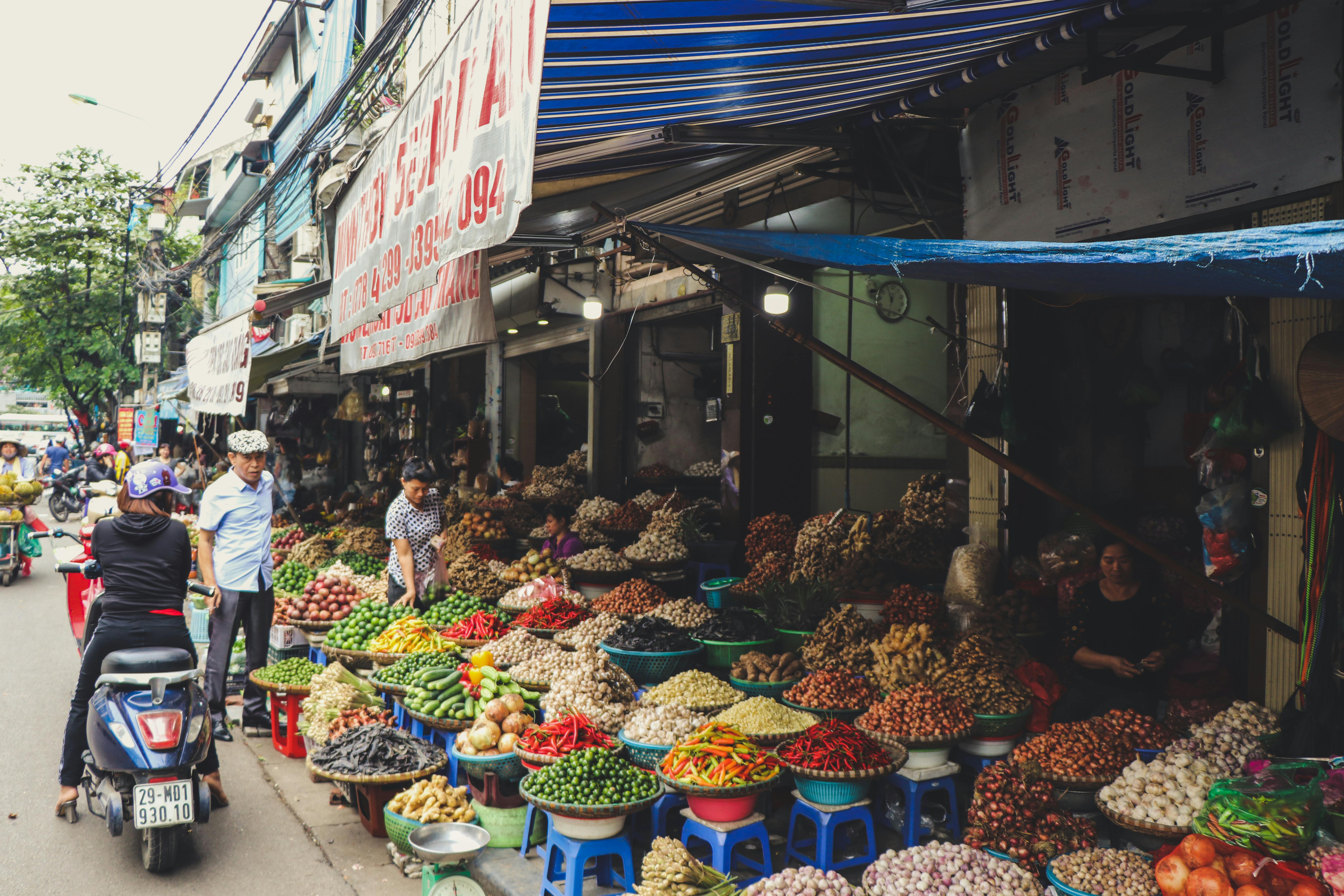
Vietnamese cooking is all about harmony and freshness, and its essential ingredients really show that. These building blocks create the distinctive flavors and textures found in dishes across the country.
Staple Foods: Rice and Rice-Based Products
Rice is at the heart of Vietnamese meals. It shows up as fluffy jasmine rice alongside grilled meats, sticky rice in festive sweets like bánh chưng, and as rice noodles in famous dishes like Phở and Bún Chả. These noodles, made from rice flour or mung bean starch, have a soft texture that soaks up broths and sauces perfectly, making them must-haves in many plates.
Essential Herbs and Vegetables
Fresh herbs are a signature feature, adding brightness and unique aromas. Tables often have cilantro, Thai basil, mint, and Vietnamese coriander. Regional touches include perilla leaves and rice paddy herbs, popular especially in central and southern areas. Crunchy garnishes like bean sprouts, cucumber, and lettuce offer refreshing contrasts to warm meals.
Signature Sauces and Condiments
Fish sauce (nước mắm) is the backbone of Vietnamese flavor, bringing salty umami to everything from dipping sauces to broths. Hoisin and soy sauces add sweetness or richness and are often used in southern and vegetarian dishes. The strong fermented shrimp paste (mắm tôm) gives bold flavor to dishes like bún đậu mắm tôm and attracts adventurous eaters curious about unique tastes.
Special Ingredients: Lemongrass, Coconut Milk, Peanuts
Lemongrass adds a bright, citrusy scent essential in marinades, broths, and stir-fries, especially with pork and seafood. Coconut milk brings creamy sweetness to southern curries and desserts, showing off Vietnam’s tropical side. Peanuts often top dishes like spring rolls and salads, adding a crunchy, nutty note and symbolizing good fortune in Vietnamese culture.
Traditional Vietnamese Dishes You Should Try
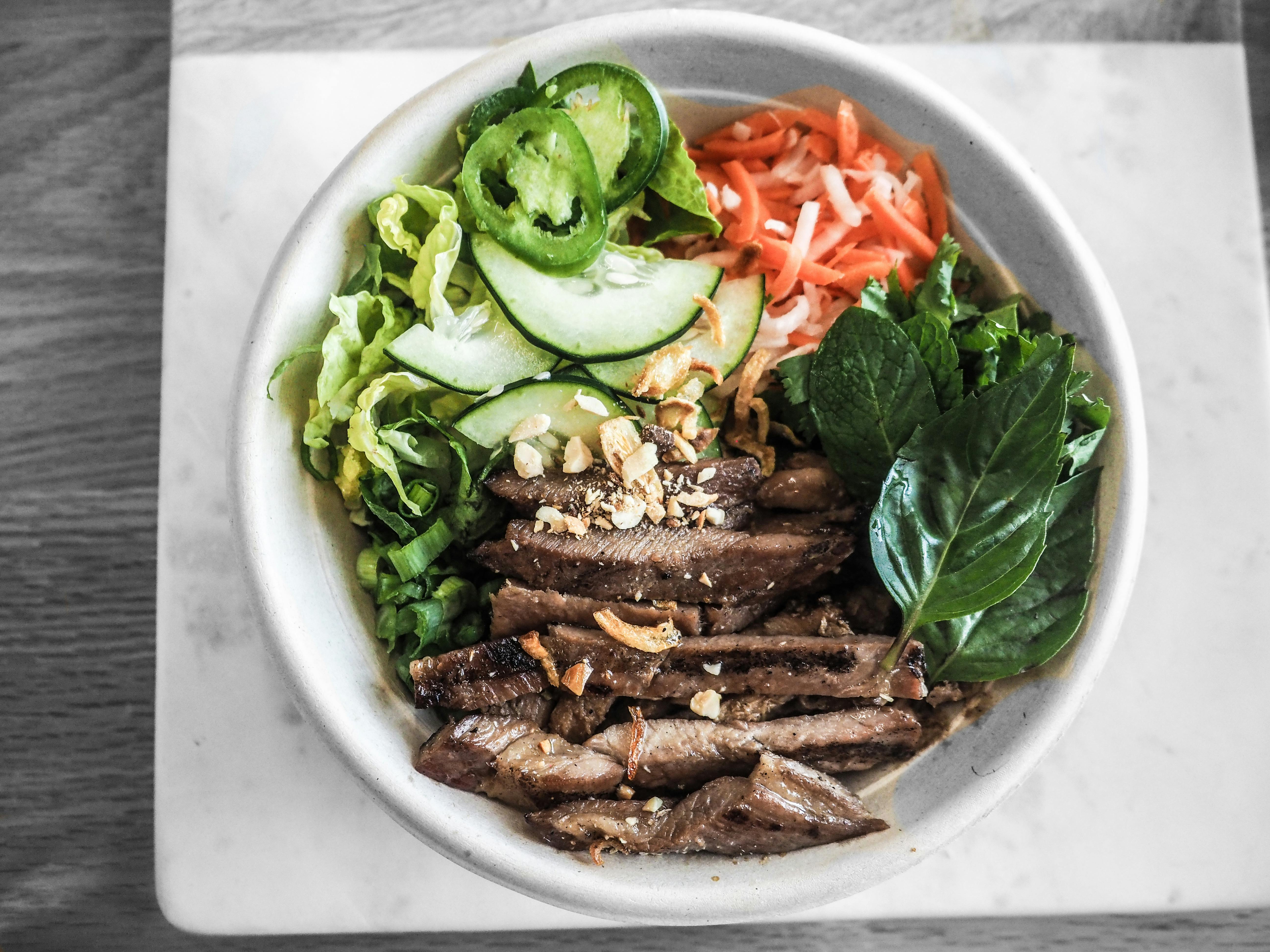
Digging into traditional Vietnamese dishes is one of the best ways to connect with Vietnam’s food culture. From world-famous classics to regional gems, these dishes showcase authentic flavors loved by both locals and visitors.
Phở: Vietnam’s Famous Noodle Soup

Phở might be Vietnam’s best-known dish—a fragrant bowl of delicate broth, rice noodles, fresh herbs, and meat, usually beef or chicken. Its broth simmers for hours with spices like star anise, cinnamon, and cloves, creating a rich, comforting taste that’s also refined. The Hanoi style features a deeper, less sweet broth, while Saigon’s is lighter and sweeter. Once a breakfast staple, Phở is now enjoyed any time of day and stands tall as a symbol of Vietnamese food heritage.
Bánh Mì: The Vietnamese Sandwich

The famous Bánh Mì sandwich perfectly blends East and West—a crisp French baguette filled with Vietnamese ingredients. You’ll find savory pork, pâté, pickled veggies, cilantro, cucumbers, and often mayo or soy sauce. Variations abound, from grilled pork belly and fried eggs to vegetarian versions. Easy to carry and packed with balanced flavors, it’s a beloved street food across Vietnam’s busy cities.
Bún Chả and Other Crowd-Pleasers
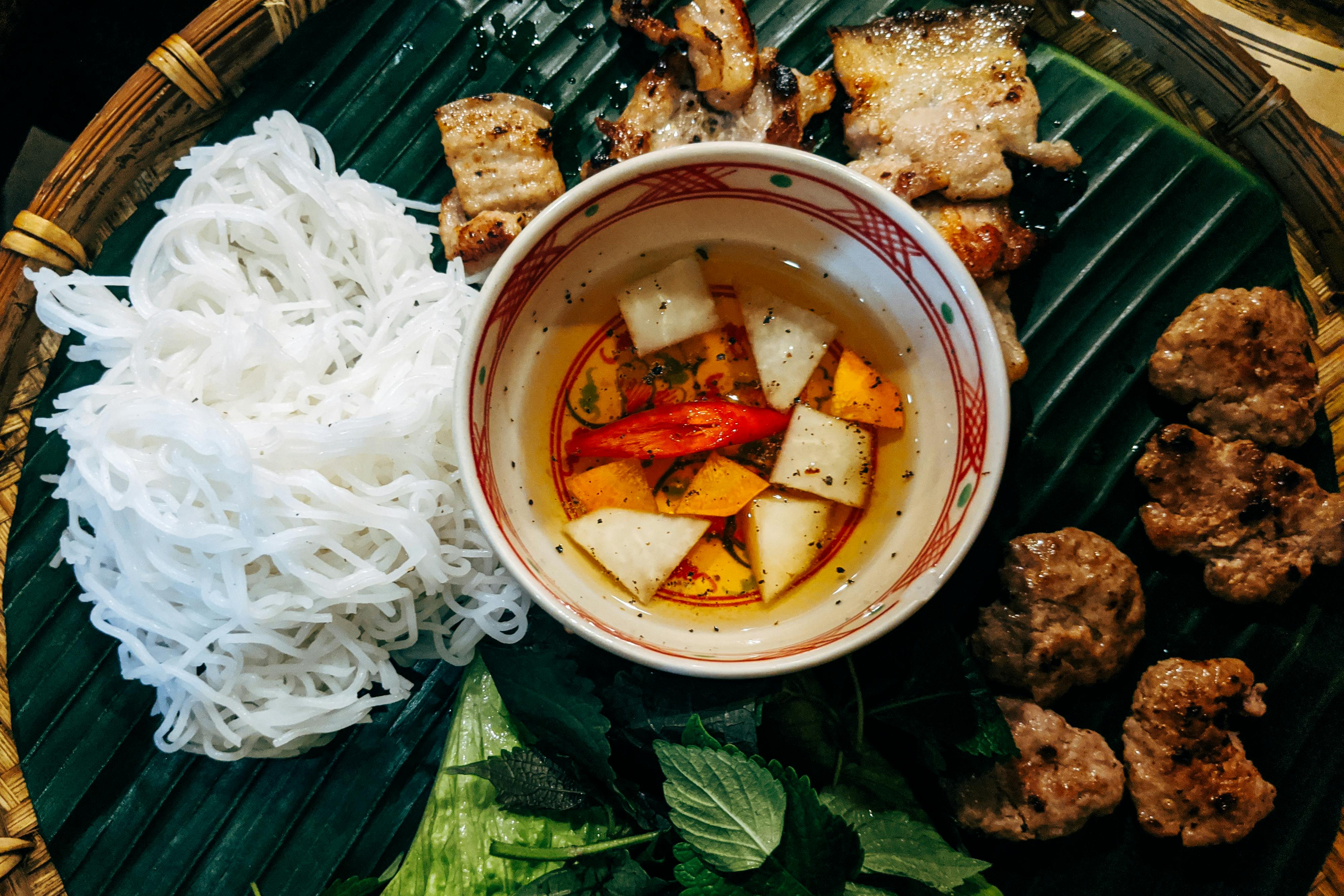
Bún Chả, a Hanoi specialty, offers grilled pork patties and slices served with rice vermicelli and a tasty fish sauce dipping mix with vinegar and sugar. Fresh herbs and pickled veggies round out the smoky, sweet, and tangy flavors. The dish gained fame abroad after being enjoyed by Barack Obama and Anthony Bourdain, earning its spot as a must-try cultural and culinary icon.
Other favorites include Gỏi Cuốn (fresh spring rolls with shrimp, pork, herbs, and rice noodles), Cơm Tấm (broken rice with grilled pork), and Bánh Xèo (crispy shrimp and bean sprout pancakes)—all showing off Vietnam’s wealth of fresh ingredients and well-balanced flavors.
Lesser-Known Regional Delights
Beyond the big names, each region has its own specialties using local ingredients and cooking styles. Central Vietnam offers Mì Quảng, golden turmeric noodles with pork, shrimp, peanuts, and herbs, served with just a splash of broth. The South delights with Bò Lá Lốt, grilled minced beef wrapped in fragrant betel leaves, and the Mekong Delta’s favorite Bánh Xèo, crispy crepes filled with shrimp and bean sprouts.
Coastal towns like Nha Trang serve up Bún Chả Cá, a light and tangy fish cake noodle soup perfect for seafood lovers. Trying these regional dishes broadens your food horizons beyond the usual tourist picks and offers deeper insight into Vietnam’s diverse flavors.
“Look for busy vendors preparing food fresh to order—that’s usually your best bet for safe and tasty traditional Vietnamese dishes.”
Local Food Expert
Regional Vietnamese Cuisine: North, Central, and South
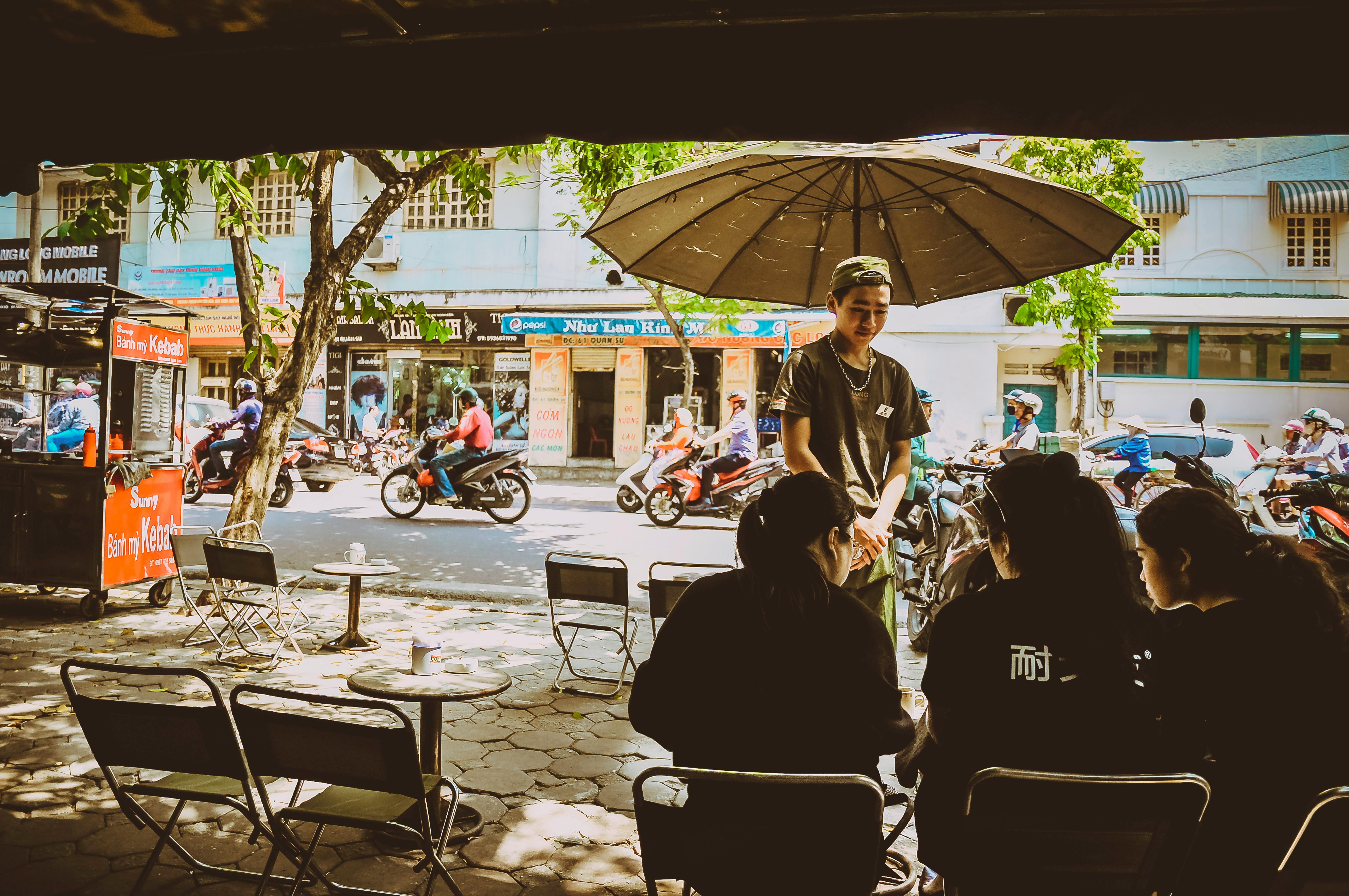
Vietnamese food is wonderfully varied, shaped by the distinct climates, histories, and cultures of the North, Central, and South. Exploring each regional style gives a richer understanding and deeper appreciation of authentic Vietnamese cuisine.
What Makes Northern Vietnamese Food Special
Northern cuisine is known for its subtle flavors and balance. It uses fewer spices and herbs than other regions, highlighting the natural taste of fresh, quality ingredients. Around Hanoi, dishes tend to be lighter and less oily, featuring gentle broths and delicate seasonings. Chinese influence shows up in stir-frying and braising techniques.
Famous dishes here include Hanoi-style Phở with clear beef broth and fresh noodles, and Bún Chả, grilled pork paired with noodles and herbs. Other northern treats include Bún Thang, a chicken noodle soup topped with finely chopped ingredients, and Bún Đậu Mắm Tôm, vermicelli served with fried tofu and fermented shrimp paste. This cuisine carefully balances fish sauce and shrimp paste for flavor.
Bold and Spicy Flavors from Central Vietnam
Central Vietnam’s cuisine stands out for its bold, spicy, and intricate flavors. This area uses more chili, salt, and herbs than the North or South, resulting in intense, fragrant dishes. Known as the land of the imperial court, food here features meticulous presentation and recipes once fit for royalty.
Don’t miss Bún Bò Huế, a spicy beef noodle soup with lemongrass and chili, and Mì Quảng, turmeric-yellow noodles topped with pork, shrimp, peanuts, and herbs served with just a bit of broth. Rice cakes like Bánh Bèo and Bánh Bột Lọc also show off the culinary finesse. Central Vietnamese food skillfully mixes sour, salty, and spicy, using pickling and preservation for added depth.
Distinctive Southern Vietnamese Flavors
Southern Vietnamese food is lively, fragrant, and sweeter than the North or Center. Tropical produce, seafood, and fresh herbs shine in dishes full of coconut milk, sugar, and aromatic greens. The result is a lovely blend of sweet, sour, salty, and spicy.
Popular southern dishes include Hủ Tiếu, a clear pork broth noodle soup; Cơm Tấm, broken rice with grilled pork and pickles; and Canh Chua, a tamarind and pineapple sour soup with fish or shrimp. Southern food also reflects French colonial and Khmer influences, adding layers of complexity. Meals here usually have a relaxed, festive vibe matching the region’s laid-back lifestyle and climate.
Knowing these regional differences helps travelers fully enjoy Vietnam’s food culture and savor authentic flavors safely across the country.
Vietnamese Street Food Culture and Popular Markets

Vietnam’s street food scene plays a lively role in daily life, offering an awesome way for travelers to dive into real local cuisine and traditions. This vibrant culture mixes history, regional dishes, and communal dining, making street stalls and markets a must-see for any Vietnam visit.
Must-Try Street Food Favorites
If you want to savor Vietnamese street food, some dishes really stand out. Phở, with its regional variations, makes a hearty breakfast. Then there’s Bánh Mì, a perfect mix of French bread and savory Vietnamese fillings like pâté, pork, and fresh herbs. Bún Chả, a Hanoi specialty, pairs grilled pork with rice noodles and greens. Fresh Gỏi Cuốn (spring rolls) offer a light, healthy bite with shrimp or pork wrapped in rice paper. In the South, Bánh Xèo—crispy turmeric pancakes stuffed with shrimp and bean sprouts—make a tasty snack. These dishes showcase the rich flavors and variety of Vietnamese street food.
Top Street Food Markets to Visit
Vietnam’s street food shines brightest in busy markets and food districts full of locals. In Hanoi, the Old Quarter and Đông Xuân Market buzz with stalls selling northern favorites like Phở and Bún Chả. Ho Chi Minh City boasts the famous Ben Thanh Market and lively food alleys in District 1, featuring southern dishes like Bánh Mì and cơm tấm. Central cities like Huế, Đà Nẵng, and Hội An offer vibrant markets where you can enjoy bún bò Huế and mì Quảng, showing off their unique culinary identities.
| Region | Notable Markets / Areas | Signature Dishes |
|---|---|---|
| North (Hanoi) | Old Quarter, Đông Xuân Market | Phở, Bún Chả, Phở Cuốn |
| Central (Huế, Hội An) | Đông Ba Market, Hội An Market | Bún Bò Huế, Mì Quảng |
| South (Ho Chi Minh City) | Ben Thanh Market, District 1 Food Alleys | Bánh Mì, Cơm Tấm, Bánh Xèo |
Tips for Finding Real Vietnamese Street Food
When you’re hunting for authentic and safe street food, it’s smart to follow the locals—busy stalls full of Vietnamese customers usually mean fresh, tasty meals. Watch how clean the vendor is, and choose those cooking right in front of you. Peak times like early mornings and evenings usually offer the best, freshest options.
- Pick busy vendors: More customers means ingredients turn over quickly and food stays fresh.
- Check cleanliness: Look for tidy prep areas and utensils.
- Be careful with water and ice: Stick to bottled water and avoid ice unless you’re sure it’s safe factory-made.
- Ask locals or guides: They can point you to trusted spots with authentic, safe food.
Getting into street food culture also means sitting on tiny plastic stools beside locals, enjoying freshly made dishes amid the lively buzz of markets and streets. This hands-on experience connects you closely with the heart of Vietnamese food and hospitality.
Food Safety Tips for Travelers Eating in Vietnam

Enjoying Vietnamese food, including its amazing street fare, is a highlight of any trip. But to keep it both tasty and safe, travelers should know about local food safety and take some simple precautions when eating on the street.
Getting Street Food Safety
Street vendors serve authentic and delicious food but often lack the strict hygiene rules seen in formal restaurants. This can increase the chance of foodborne illnesses like E. coli or Hepatitis A. Risks include dirty prep surfaces, contaminated water or ice, poor food storage, and bad sanitation during handling. Being aware of these helps you enjoy local tastes more safely.
Simple Tips to Eat Safely
Always go for hot and freshly made food. Heat kills most harmful germs, so pick stalls where you can see food being cooked fresh. Skip raw or undercooked meats, seafood, and eggs since they carry higher risks. Only drink bottled or filtered water, and avoid ice unless it’s clearly factory-made (look for a hole in the ice block).
Keep an eye on vendor cleanliness: make sure food is covered from flies, and check if utensils and hands look clean or if gloves are worn. Carry some basic meds for minor tummy troubles, just in case, so you can enjoy your trip without worries.
Choosing Clean Food Vendors
Pick busy stalls with lots of locals; more customers mean fresh ingredients. Prefer vendors who cook or reheat your food in front of you instead of serving pre-cooked dishes left out. Watch how food is handled: clean vendors tend to use tongs or gloves and wash hands frequently.
Look around—the place should be tidy without trash piles or exposed food attracting flies. Vendors with smaller, focused menus often have better quality and hygiene. Also, check local reviews or ask trusted locals for the safest, most authentic spots.
Dining Etiquette and Cultural Customs in Vietnam
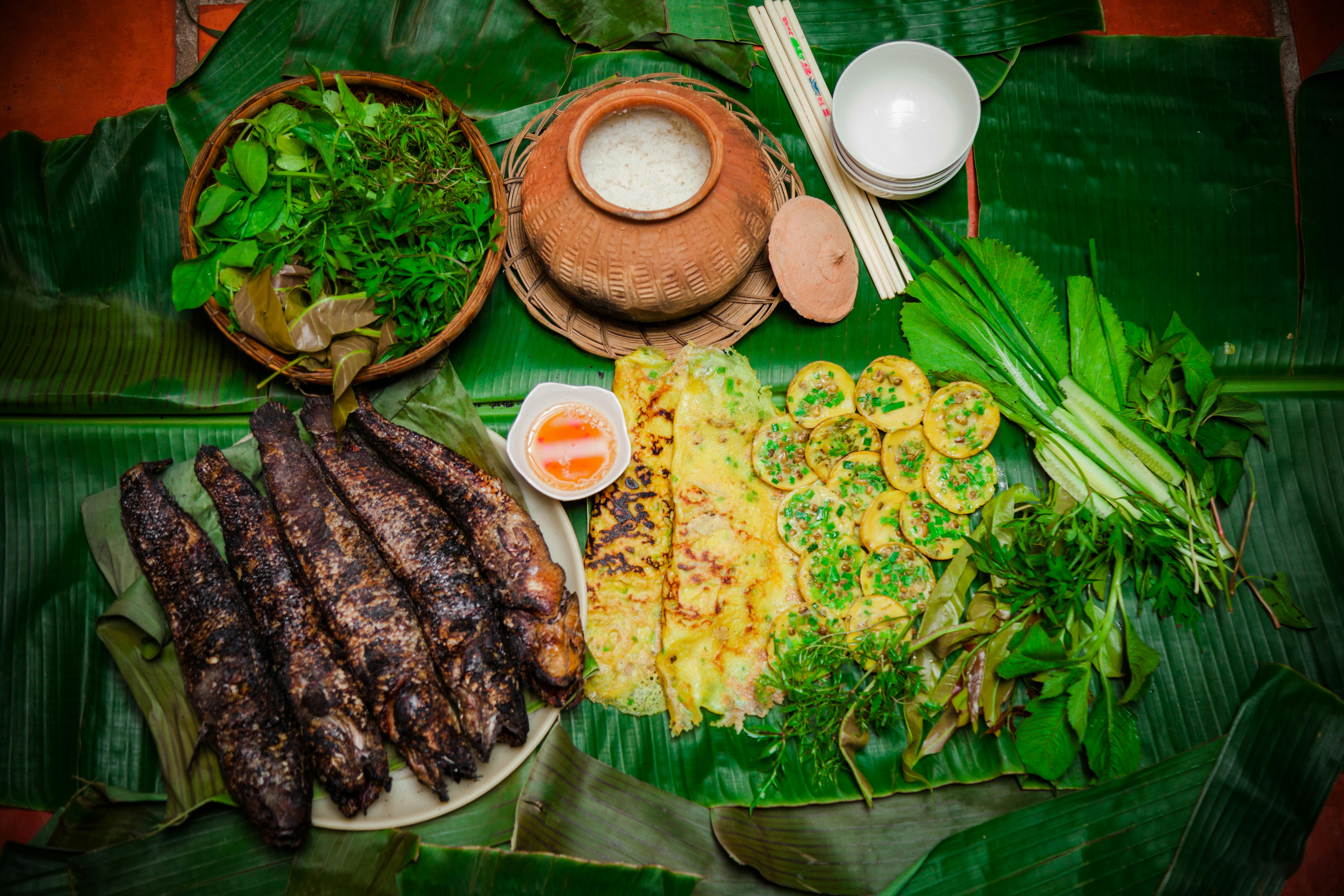
Vietnamese dining etiquette is deeply rooted in respect, community, and tradition. Knowing these customs makes your meal more enjoyable and shows genuine appreciation for Vietnamese culture when you enjoy its food.
Common Vietnamese Dining Practices
Meals are usually shared, with dishes placed family-style in the center for everyone to enjoy, while each person has their own bowl of rice. Multiple dishes—meats, vegetables, soups—are eaten together for a balanced flavor experience. Diners serve themselves but are expected to put others first, especially elders and honored guests. Seating often reflects social order, with elders seated first and younger folks waiting for the oldest to start eating.
Respect and Table Manners
Respect is key at Vietnamese meals. Serving others before yourself, especially elders, is important. Chopstick etiquette matters too: never stick chopsticks upright in a rice bowl—that’s like incense for the dead and considered bad luck. Avoid tapping chopsticks on bowls or passing food directly chopstick-to-chopstick, which has negative cultural meanings. Eating quietly in modest portions and avoiding loud noises also show good manners. Polite chats focusing on food and positive topics create a warm, friendly atmosphere.
The Tradition of Sharing Meals
Meals here do more than fill bellies—they strengthen family and social ties. Sharing dishes symbolizes unity and equality, and actively serving and eating together promotes harmony. It’s polite to wait for elders to finish before leaving the table, and finishing your food shows respect to the cook. These customs highlight modesty, togetherness, and honoring relationships—core to Vietnamese food culture.
Recommended Food Tours and Local Culinary Experiences

Exploring Vietnamese cuisine and food culture is an amazing adventure, and taking food tours or joining local culinary experiences can turn it into something unforgettable. These hands-on activities introduce you to true flavors while connecting you with the traditions and people behind the food.
Top Food Tours to Check Out
Vietnam has plenty of great food tours for travelers eager to taste authentic flavors safely and enjoyably.
In cities like Hanoi and Ho Chi Minh, guided street food tours navigate vibrant night markets showcasing iconic dishes like Phở, Bánh Mì, and fresh spring rolls.
These tours often reveal hidden local favorites off the beaten tourist path, giving real insight into Vietnam’s lively street food scene. Many also highlight regional specialties from North, Central, and South, offering a tasty overview of Vietnam’s diverse food landscape.
Here are som popular food tours in different cities:
- https://www.hanoistreetfoodtour.com
- https://hafoodtours.com/
- https://danangfoodtour.com/
- https://saigontastetours.com/
- https://www.hueflavor.com/
- https://www.huefreewalkingtour.com
Visiting Markets and Joining Cooking Classes
Checking out local markets is a must for anyone wanting to understand Vietnamese food beyond just eating. Markets burst with fresh produce, spices, and snacks, giving a sensory-rich experience.
Hanoi
- Dong Xuan Market: Largest and oldest indoor market; great for local foods, fresh produce, clothing, and souvenirs. Located in the Old Quarter, bustling atmosphere from early morning until late.
- Hom Market: Renowned for its huge selection of fabrics and affordable goods; also excellent street food options.
- Nghia Tan Market: Famous local spot for traditional Hanoi street foods and fresh produce.
- Hang Be Market: Nestled in the Old Quarter, this historic market is ideal for experiencing local food and daily life.
Da Nang
- Han Market: The city’s best-known central market, offering fresh produce, seafood, local specialties, and handicrafts in a lively setting.
- Con Market: The largest local market, famed for its street food paradise and a maze of over 2,000 stalls. A must for sampling Da Nang’s signature dishes.
- Bac My An Market: Beloved for authentic local eats—try the legendary avocado ice cream and fresh seafood. Great for cheap, delicious street food experiences.
Hue
- Dong Ba Market: Hue’s largest and oldest market, rich in fresh produce, street food (especially Hue specialties), handicrafts, and daily essentials. Best visited early or late for lively sights.
- Ben Ngu Market: Praised for its wide variety of affordable goods and classic Hue vibes, with a strong emphasis on herbs and local foods.
- Phu Hau Market: The city’s main wholesale market with a bustling trade in fresh foods and local supplies.
Ho Chi Minh City (Saigon)
- Ben Thanh Market: The iconic market in central District 1. Famous for souvenirs, textiles, street food, and lively night activities—a true symbol of Saigon.
- Binh Tay Market: In Chinatown (Cho Lon), great for fresh produce, dried goods, and a diverse culinary heritage.
- Tan Dinh Market: Another local favorite known for its affordable shopping and excellent food stalls, with a unique historic atmosphere.
- Ba Chieu Market: Popular among locals for groceries, fresh produce, and delicious street food—especially lively in the evenings.
Hoi An
- Hoi An Central Market: At the heart of Hoi An Ancient Town, famous for fresh produce, seafood, local dishes (like cao lau, white rose dumplings), and vibrant lanterns.
- Nguyen Hoang Night Market: Bustling at sunset with food stalls, souvenirs, and lanterns; set along the river for a magical evening atmosphere.
- Tan An (Tiger) Market: North of Ancient Town, frequented by locals for fresh foods, fish, and fruits at excellent prices—a window into real Hoi An life.
- Ba Le Market (Cam Chau): Traditional countryside market with top-quality herbs, vegetables, and friendly vendors—a peaceful alternative to the busier town center.
Tips for Visiting Vietnamese Markets
- Arrive early for the freshest picks and liveliest ambiance.
- Bring cash (small denominations preferred).
- Bargain confidently but politely—it’s part of the culture.
- Sample local specialties—each market is a culinary destination.
- Beware of pickpockets in crowded areas.
Many tours combine market visits with cooking classes taught by local chefs, where you learn to make traditional dishes yourself. This hands-on approach teaches you authentic recipes and introduces key ingredients like fresh herbs, rice noodles, and fish sauce.
These classes also often cover cultural background and food safety tips, so you can recreate these flavors confidently at home.
- https://www.apronupcookingclass.com
- https://danangcooking.com/
- https://huecookingclass.com/
- https://www.momcookingclass.com/en
- https://hoianecocookingtour.com.vn/
Final Thoughts
Taking a culinary trip through Vietnam offers so much more than great food—it’s a window into the country’s vibrant history, incredible regional variety, and cherished traditions.
Knowing the basics of Vietnamese cuisine and food culture, from the balance of the five key tastes to the importance of fresh herbs and classic condiments, helps you truly enjoy the unique flavors and communal spirit in every dish. Exploring lively street markets, respecting local dining customs, and joining food tours make this food adventure even richer.
Whether you’re savoring a steaming bowl of Phở on Hanoi’s busy streets or biting into a crispy bánh xèo in the Mekong Delta, let curiosity and respect guide your food journey through Vietnam’s culinary treasures.
Keep food safety in mind by choosing busy and clean vendors, and dive into communal dining that turns meals into unforgettable cultural moments. As Vietnamese food continues winning hearts worldwide, the real question isn’t if you’ll taste these flavors, but how deeply you’ll connect with the heart of Vietnam through its incredible cuisine. So, why not start planning your tasty adventure today?
- Key Takeaways
- Introduction to Vietnamese Cuisine and Food Culture
- Core Principles and Key Flavors in Vietnamese Food
- How Geography and Culture Shape Vietnamese Food
- Key Ingredients in Vietnamese Cooking
- Traditional Vietnamese Dishes You Should Try
- Regional Vietnamese Cuisine: North, Central, and South
- Vietnamese Street Food Culture and Popular Markets
- Food Safety Tips for Travelers Eating in Vietnam
- Dining Etiquette and Cultural Customs in Vietnam
- Recommended Food Tours and Local Culinary Experiences
- Final Thoughts
Get your FREE Monstera Art download
Join our WanderLife Studios mailing list to get updates about our work and be the first to know about upcoming art products.
As a Thank You Gift, you will get this wonderful hand-drawn Monstera Line Art as a digital download for FREE .

